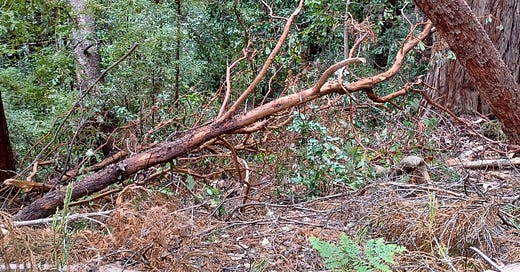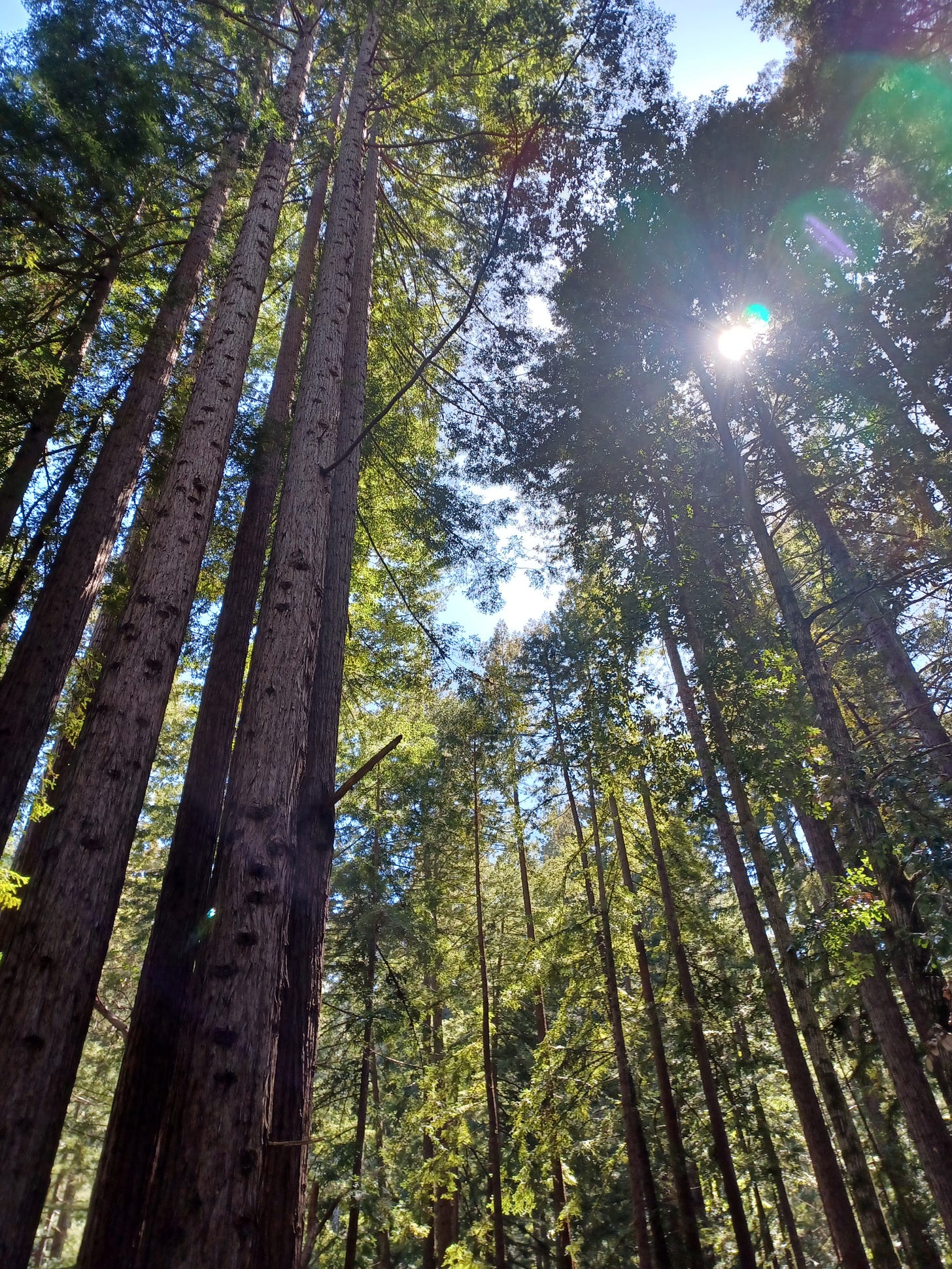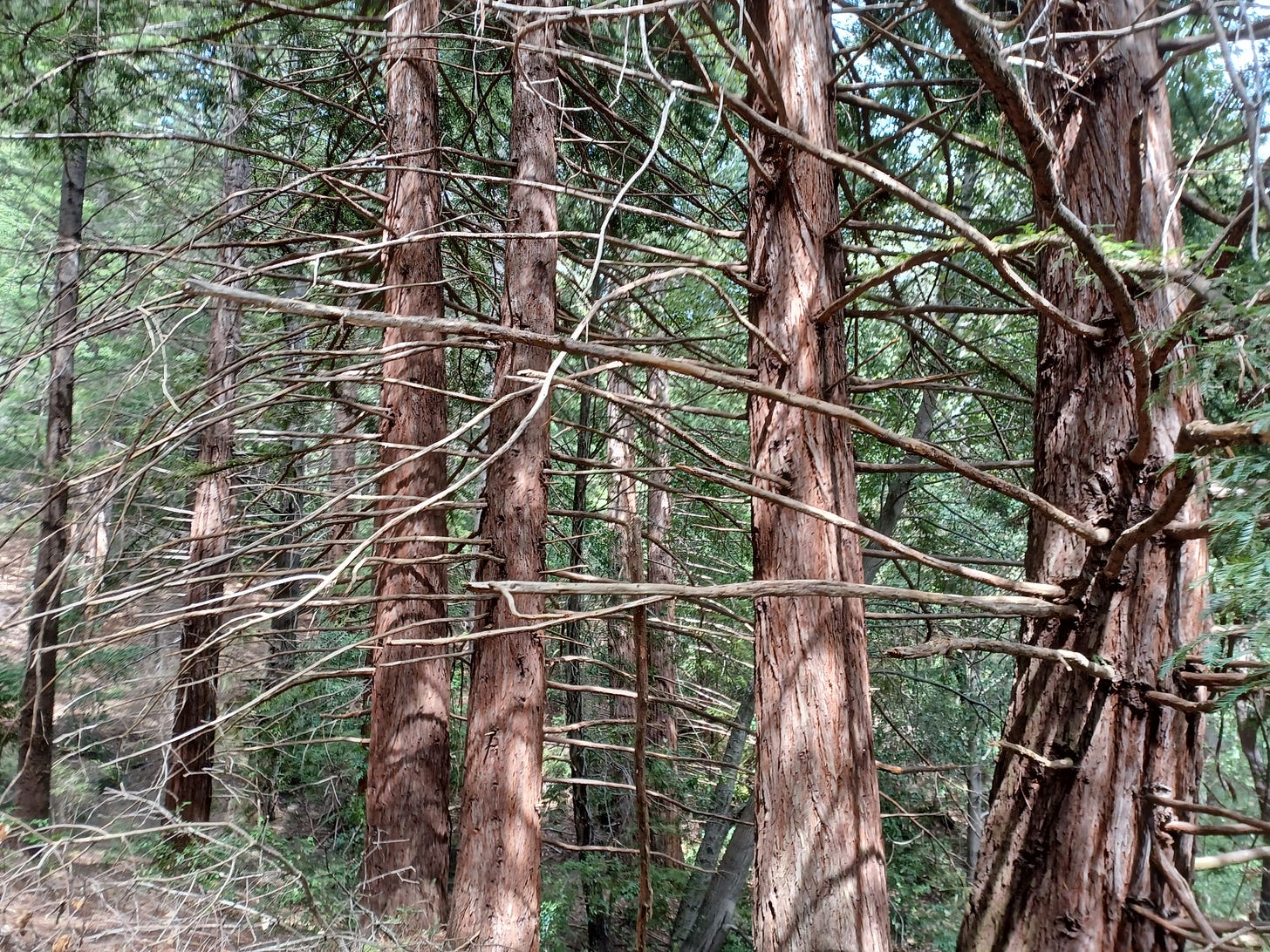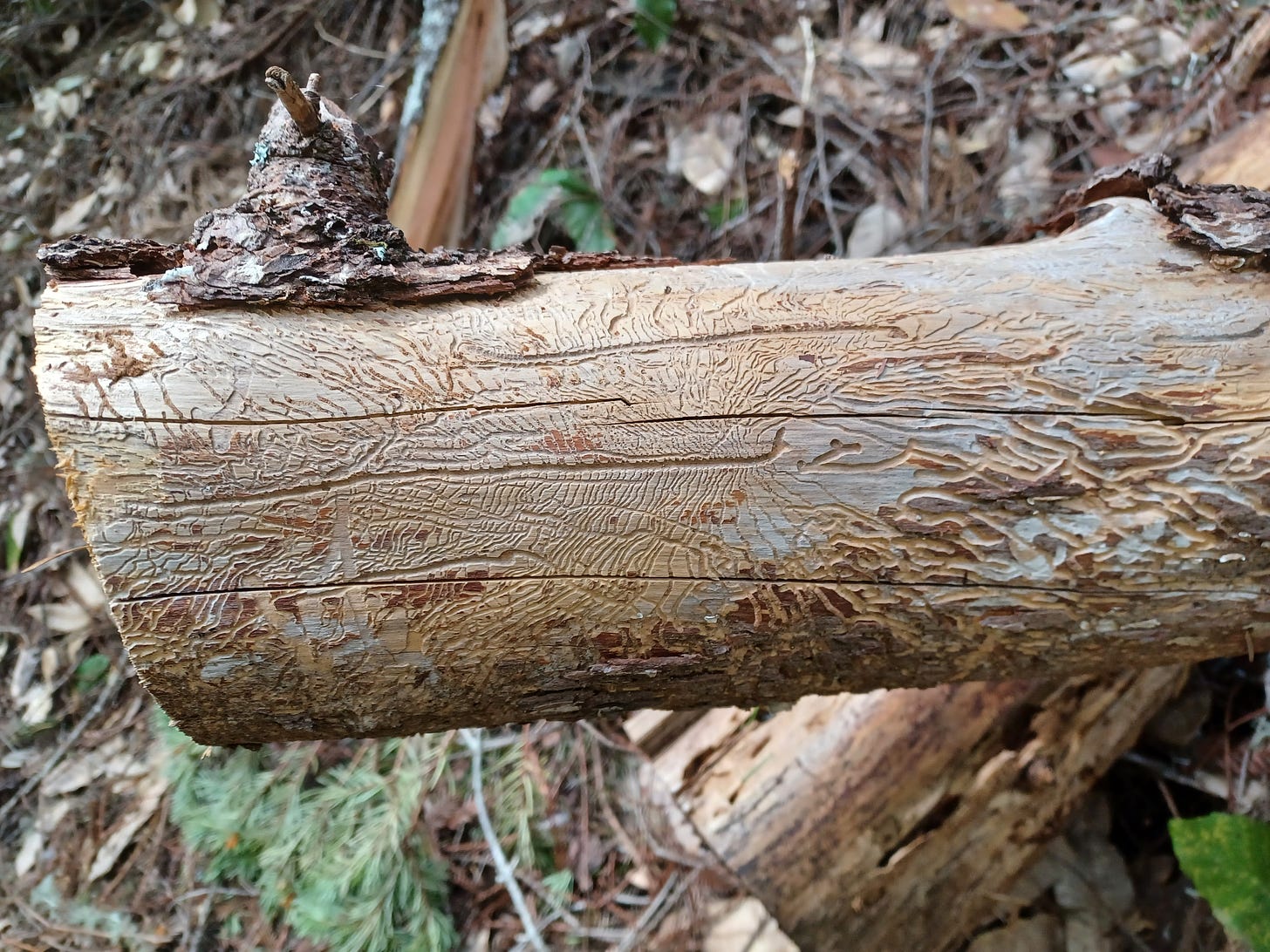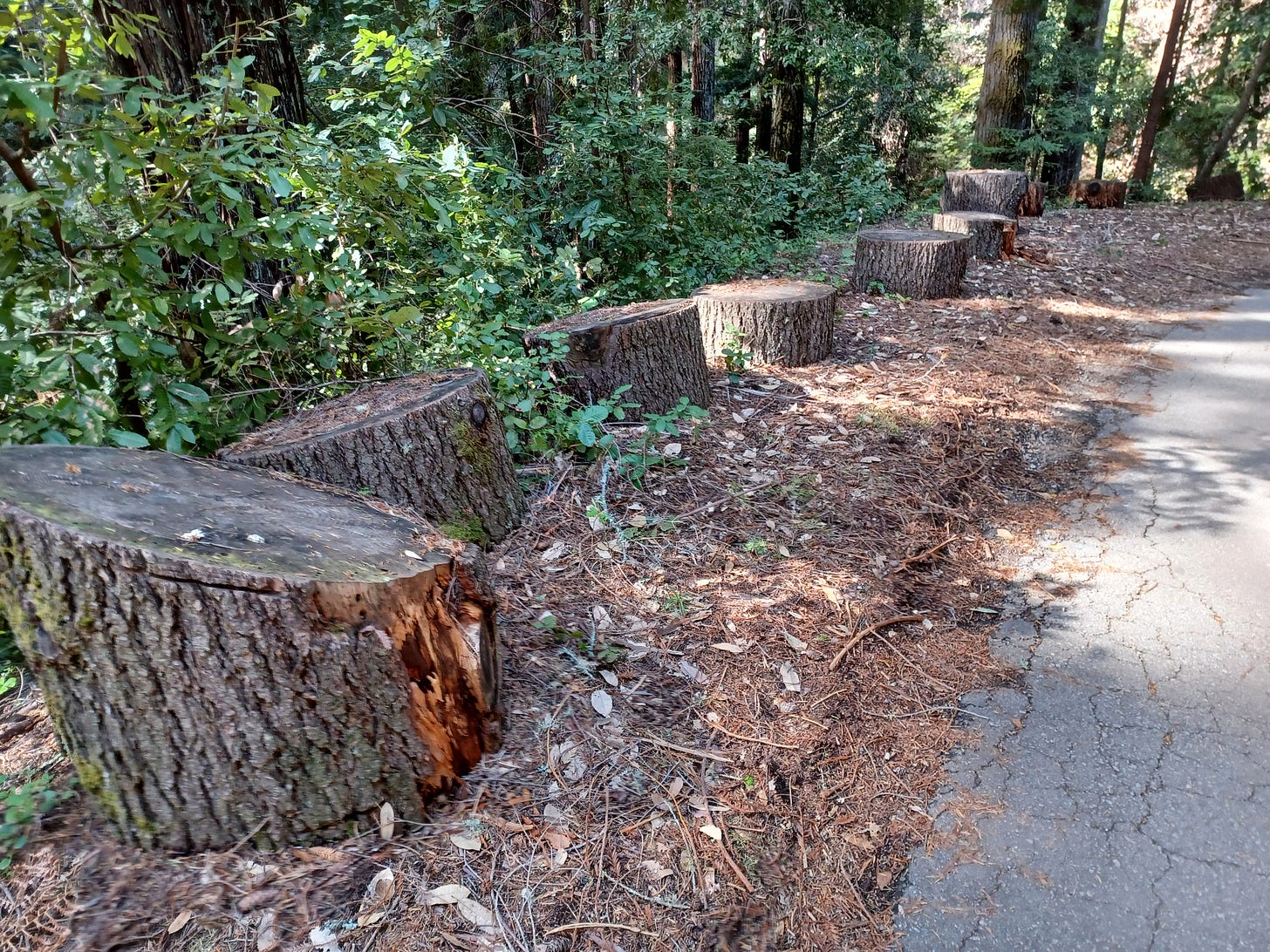Speeding Towards Trust
On the aftermath of trying to provide insta-community in times of connective drought
Welcome to Wandering Grace. I will be sharing essays exploring the themes of place and (be)longing1 every other Thursday, and bonus snapshots from the road on alternating Sundays. Read more about the project here.
In the coming weeks, I might need to alter the posting schedule to either switch the essays to Sundays and the bonuses to Thursdays — or to post everything on Sundays. I’ve mostly been resisting because I don’t necessarily want to set myself up to work all weekends, but my new rhythms might require that anyway. I ask for your patience and grace at the awkward calendar bumps that are bound to happen in the transition.
Last week’s bonus was a round-up of facilitation tools to break up the tyranny of the large circle gathering. May your gatherings be ever more embodied and multi-modal!
“Will you Jam again?” my friend asks me near the end of the gathering in the redwoods. Apparently there are serial Jammers who attend repeated Jams over multiple years. Yes! Jams organizes and hosts jams around geographic locations and around social issues and around identity, so there are plenty to choose from.
“Honestly, I don’t know. This experience was so intense. It wasn’t great for my neurodiverse brain.”
“How would you redesign or facilitate it differently if you could?”
“I don’t know! I would slow us way down and give us a lot more downtime, maybe do smaller chunks stretched out across multiple weeks…but would it even still be a Jam without the intensity of five days and 30 people on retreat in a remote location? Am I just talking about building community slowly and unsexily and locally then?”
***
Spaces like jams help us name and practice the muscles that are conducive to building sustainable community support in our lives:
asking for support and receiving collective care
moving into stretch zone together, helping each other grow
choosing emotional vulnerability in order to connect (instead of armoring up as defense against the risk of showing heart-skin)
believing in your own and others’ belonging (being seen and heard for who you are)
showing appreciation via gift-giving and affirmations
The summer camp vibes of these experiences comes from having a built-in social crew to spend downtime eating together at shared meals and playing games that devolve into laughter and talking late into the night. It highlights and amplifies what some of us may be lacking at home: a density of emotional connection, hangout buddies, access to intimacy, and a tangible web of physiological and psychological support.
When it works, it’s a taste of beloved community. In these retreat experiences, in remote forests, away from the infrastructure of our daily lives, we receive glimpses into what we actually want and yearn for and need in our daily lives.2
Sometimes, upon returning home from a retreat experience, we experience the withdrawal of the comfort of support and the aphrodisiac of belonging — or even just the disappointment of having to feed ourselves all the time again.
It’s ironic that we need to recover from getting a taste of beloved community.
***
California has been going through seasons of drought and deluge. The winter of 2022-2023 saw above-average rainfall in California, which has leant a lushness to the cities who I’m not used to seeing so decked out in green. I’m familiar with these patterns from my time in Texas as well. The problem is that one season’s worth of extra rain doesn’t end the drought: the land is often unable to absorb the excess water. Floods destroy above-ground infrastructure, while water tables remain low.
They say the trees are titrating to meet their water needs after so much rain.
If you were to encounter and help a person who has been parched coming out of a desert environment, you wouldn’t hand them a gallon of water which they might gulp down all at once. They must intake water slowly, sip by sip.
Otherwise, vomit. Otherwise, rejection.
The same is true (in my body at least) when I start receiving care in an area where I have historically not had my needs met — to the point where I had stopped expecting that they could be met at all.
I might reject it. I might be overwhelmed by grief around all the times the need went unmet.3 I might be suspicious of receiving the offering. I definitely don’t want to get used to this feeling of satiation.
It takes time to open up to care again.
***
One of the reasons I applied for this Jam was to be in a room with other folks of radical-leaning, impact-oriented Asian Diaspora because it’s something I’ve been missing in Oregon. And yet, the speed of the whole thing feels too intense for my nervous system.
The jam felt like the opposite of “moving at the speed of trust”4 — it felt like speeding into trust for the sake of community.
Upon leaving the Quaker Center and the second-growth redwoods forest on the last day of the Jam, I supposedly have 28 new BFF’s, a new WhatsApp thread and a GoogleGroup to catch up with, and a whole new “community” body of relationships to upkeep and to integrate into my existing webs and connections and social infrastructure of relationships.
It’s like trying to insert a shotgun marriage wholesale into your life overnight. Post-Jam reintegration feels like my bodymind catching up to the “bond” and “trust” that our mindbodies have decided exists between myself and these people who are still practically strangers to me.
Community requires trust, and trust is built via consistency, over time. Without time, can true community exist?
Speed can override all sorts of red flags or alarm bells or intuitive parts that may be quieter: Do I actually trust all of these people?
When conflict arose in full-circle work during the Jam itself, we tended to it collectively. I learned from watching the facilitator masterfully move us through the emotions without rupturing the bubble of belonging that the group had built up over the days. I saw individual relationships deepening as the week progressed.
But I leave the Jam with mixed feelings about the draw toward conflict as a tool for connection. What if I don’t want to deepen my relationship with these particular people? I’d rather do conflict within community, where we’re already in committed relationships with each other.
A takeaway and teaching from the Jam is that “conflict is the spirit of the relationship asking to deepen.”5 When asked to move through conflict with near-strangers, does that then become a shortcut into bonding with them? It feels bit like a bait n switch: “we might as well be BFF’s now” because we’ve already invested all this time and energy into these relationships through the tough emotions of conflict…
***
Partway through the Jam, my roommate, who is fresh out of undergrad, asks me “is this a cult?” in earnest.
My kneejerk reaction is to downplay the question with an, “of course not.” Because I’m familiar with this trope, this joke. People often accuse anything that whiffs of community as cultlike.6 Maybe it’s a defense mechanism against the fear of emotional intimacy or a ward against the slippery slope between interdependence and co-dependence. Maybe it’s a quick jujitsu maneuver against the yearnings for community that are so deep yet seemingly so unattainable, that it’s easier to belittle or dismiss7 the possibility of anyone experiencing the power of community than to grieve its absence in one’s own life. The question of cults also flags the fear of: will I have to lose my sense of self in exchange for belonging to a collective?
Is this a cult? No.8 But community can feel cultlike because dependence on community sometimes feel dangerous to us as “responsible adults” trained as “independent individuals” under capitalism.9
One reason people are susceptible to cults is because they crave community.
***
It’d be simpler if the fervent exchange of contact info amidst last-day-of-retreat hugs and “keep in touch!” admonishments fizzled out into crickets and silence as is mostly what happens after retreats and conferences and intensives and camps.
But the conditions here with this particular Asian Diaspora Jam (and maybe other Jams as well, to hear tell) fueled the momentum of transitory connection into actual community.10 I watch the WhatsApp thread and continued selfies from get-togethers pile up over time.
What I feel is not quite jealousy or merely FOMO, though it’s tempting to categorize it as something simple. It’s more an amalgamation of contradictory feelings:
One is genuine joy11 to see folks gathering and connecting across multiple cities, moons and months after our initial Jam. As a community weaver, I feel genuine awe and appreciation for the invitations and the weave that I can see strengthening with each ask for support, each bid for connection, each shared meal, each heart emoji.
I also feel an aversion to the idea of joining some of these Bay Area ‘Jamily’12 gatherings…which is intriguing, since I am considering the Bay Area as one of the places I might move back to.
***
Periodically, I wonder about other folks on the Jam’s WhatsApp thread who live further afield. For me, back in Oregon, it’s hard to watch evidence of something you know you want and probably deeply need, but which you cannot access from afar.
Trees respond to drought conditions with “root biomass adjustments, anatomical alterations, and physiological acclimations”. In other words, they change their physiology to be able to survive on less water, even when they would thrive or grow differently under different conditions.13
I liken this to my penchant to justify away my needs when faced with the possibility that they might not get met. I start to question whether I even want the thing in the first place, or whether it’s even possible under capitalism. It’s a defensive strategy that doesn’t erase the need itself, even though I have already reshaped my life to need less and less of it over time. It’s a survival strategy that only gaslights myself into self-doubt and anxiety around wanting something I can’t access.
I’m thinking here of my own (lack of) access to cultural belonging within Asian diaspora and culturally-mixed diverse spaces over the last few years I’ve spent in Oregon. “I don’t need to live in a place like Houston. I see Asian folks all the time on Zoom. One of my housemates is Chinese!”
I’m also thinking here about the need for and (lack of) access to community in general. The ways so many of us crave community — and yet balk at the physiological anatomical infrastructural changes required of us to participate in its flows of abundance — when we have already learned to shut off some of our receptive capillaries, to make due with less robust networks of support, have dropped leaves of hope in the droughtlike conditions of capitalist-coopted versions where every company and social media platform is suddenly creating “community”.
I imagine that it would take time for trees to reverse any physiological and anatomical alterations that they made during drought even when water becomes more readily available again.
Maybe there is a wisdom to this slowness as well — to not flood capillaries or overwhelm vessels which are accustomed to less water, but to titrate them, to stretch-zone into them, over time, into ever-expanding resource. With possibility for continued adjustments, adaptations, and resiliencies, toward both survival and thriving.
I came out of my Jam experience a little w(e)ary of the way we sometimes approach community as if we can offer quick fixes, as if we can build lasting connections overnight14 — but this may be because I experience much of dominant world’s pace as violent to my absorptive brain, too-quick nervous system, and too-slow body. There is a cost to quick and intense that often gets borne by marginalized bodies in invisible ways. Or the collateral energy required becomes subsidized under the silence of the ends justifying the means.
“What if the way we respond to the crisis is part of the crisis?” asks the Emergence Network.
…
My mixed feelings about the WhatsApp thread also become a microcosm of my allurement and aversion to city life as an American.
The seemingly binary nature of the urban-rural dichotomy15 is something I am desperately trying to see beyond or through on this Healing Pilgrimage. The tradeoffs of all my moves haunt me.
I describe the conundrum to people along my pilgrimage like this: in the city you get access to cultural community and belonging, but the tradeoff is the extractive hustle needed to afford to live in a city. Outside the cities, there is more space+time to breathe and access to nature and a deeper relationship to land, but the trade-off is whiteness.16
Many familiar, seemingly-simple, tropey variations of what I’m talking about are: immigrant families moving for jobs, second gen kids moving away for college, migrants traveling across national borders to make ends meet, queer folk gravitating toward larger cities for safety or belonging,17 uprooting self again and again for the sake of career. And in the other direction: white flight in general, tech workers abandoning cities for tiny homes in the woods, hippie liberals starting coops and communes on land where they can get it.
These movements have been shaped by colonialist design and policed by economic forces of investment and disinvestment, which are further reinforced by cultural narratives of aspiration and mobility.
Kazim Ali writes in Northern Light about the psychological and cultural tolls of forced migration on Aboriginal/Indigenous communities in settler-named Canada in the ever-changing guise of saviorism via residental schools, or family separation, or land grabs.
“…others have argued in national newspapers that a solution to the suicide epidemic in places like Cross Lake would be urban resettlement of the young population. The truth is that there are already many urban Indigenous communities. Those Indigenous Peoples who have migrated to the cities, mostly to the south, whether in search of housing or economic opportunities, or because they were forcibly taken from their communities by Canadian Family Services, have faced more difficulties than pundits like Mason have acknowledged, including housing and job discrimination and other kinds of structural racism...”
“In response to these grave challenges, some southern Indigenous urban communities have been organizing and building their own community organizations and institutions, such as Neechi Commons in Winnipeg. But the notion that compounding the original land theft of colonizers with a further forced relocation to urban centers would mitigate the challenges faced by Indigenous communities seems misguided at best and criminal at worst.”
As part of my design research days, I found myself in China in 2015 interviewing moms who had migrated to urban centers to work in factories for foreign companies, having left their children behind in villages to be raised by grandparents. They shared heartbreaking tales of missing their kids every day, and the mass reverse migration during Lunar New Year to reunite with family for a pittance of time. Sitting in the discordance of my too-posh hotel room after visiting dorm-like apartments where migrants slept 8 or 12 to a room, I couldn’t quite fathom the global ripple effects of a whole generation of Chinese children raised without their parents for the sake of “survival” via economic growth, but I could feel the horrors of it creeping into my edges, weighing down my bones.
In the series finale of Reservation Dogs, Daniel’s mom Hokti shares wisdom with Willie Jack about taking care of community after a death in the community: “What do you think they tried to do when they were trying to destroy us? They were coming after our communities because they knew if you break the community, you’ll break the individual.”
Who gets to choose — who really gets to choose — where they live, and why, and on their own timelines? Who gets to feel safe where? And at what costs — literal and metaphorical?
How are our migration choices complicit in enacting our own unraveling? What would it require of us to move toward collective re-raveling? And at what costs?
***
As I look at photos of reunion and communion on the WhatsApp thread back in my predominately-white suburban Oregon milieu, I also feel the ghostly echoes of generational longing. It’s what I imagine my parents and grandparents might have felt looking at evidence of community “back home” knowing that the choices they made in migration shifted irreparably the equation of their belonging.
It’s the familar ache of diaspora — a yearning to return to a community of care alongside the fear that you’ve changed too much to feel at home in that culture any longer.
Who gets to stay where they feel most connected to and interwoven with culture and land — and who gets to make that choice in ways that are fully supported, not only familially but also structurally and systemically?
***
Oregon changed me. It changed my relationship to my cultures of origin, as I learned to survive without the resource of being connected to the water table of cultural diversity from which to nourish my roots.
Oregon is also where I unlearned the pace of capitalism in my body, so that the economic equation of city living feels unviable to me now.
To get back to the city — if at all — will take a much slower, much longer, much more meandering route.
In the meantime, my relationships — to these shores and to these lands and to my peoples — continue to draw me onward in curious ways.
In solidarity with a free Palestine, #CeasefireNow.
A friend Sara forwarded these reflection questions from Anne Helen Peterson’s substack:
“What does your community *actually* look like now? What do you *want* your community to look like? The essence: what pillars of community have you found, and what are you still seeking?”
Some tidbits from Meednachi’s vital Decolonizing Non-violent Communication:
“critically assess the ways we have been conditioned to identify, prioritize, and get our needs met. imagine alternate ways of meeting these needs. acknowledge, mourn, or be present with the reality that some needs have been so chronically unmet that it is hard to believe they will ever get met. develop acceptance with the reality that we cannot meet all needs at the same time. increase our sense of agency over the strategies we choose.”
“Toxic anger is not anger. It is, in truth, a graveyard of grief. A mass gathering of unexpressed feelings and unmet needs, both intergenerational and individual. Systemic conditions disallow impacted folx from expressing grief or heartache…As individuals and as a collective, our health and well-being depends upon our willingness to find space to do it anyways.”
adrienne maree brown, Emergent Strategy
Kazu Haga, Healing Resistance
Those in authentic community often reinforce this same narrative by joking that they are an “art cult” or they joke about being “#notacult”. It’s the flipside of the defense mechanism — we know that e.g. this ritual that felt deeply powerful to me might look suspicious to an outsider, so let me try to preempt the dismissal of something that was actually really meaningful to me and/or reclaim the word cult as an inside joke.
“Casual, automatic suspicion and disapproval is a key enforcement mechanism of social norms.” - Amy Gahran, Stepping Off the Relationship Escalator
To be really clear, some of the signs of a high-control group AKA actual cults are that they are isolating, controlling, and discourage questioning. Jams aren’t cults, but it’s generative for me to get into the complexities of the venn diagram of methods and motivations of communities and cults — and it’s responsible for all of us to be aware of the fears, potential exploitation, and potential for abuse that are possible in both arenas.
If any person or group tries to limit or control your relationships outside of theirs, RUN — that’s a sign of priming for abuse. Isolation (ironically…or maybe naturally?) is the biggest sign of a cult. Communities are about expanding outward and inter-connecting up. For more, see Timothea Haider’s zine Is This Cult Shit?
“The individual is not a unit of care. The individual is a unit of capitalism. Care is an interconnected, ecological possibility.” - Alexis Pauline Gumbs on the Possibilities Podcast
The conditions with this Jam: a plurality of participants live in or near the Bay Area; which itself is an oft-enough and easily-enough visited location by other Jammers to create excuses for multiple gatherings; that some of the organizing team live here also; that many participants are community organizers themselves, so have the intuitions, tools, and follow-through to make appealing invitations and to show up for each other’s invitations; building off the magic of those trust shortcuts that unearthed belonging and/or visibilized potential weave. I name these here because I want to make it a practice of visibilizing the often-invisible (or invisibilized) intuitions, labor, and magic that goes into building and maintaining and nurturing community. I want to write limitless Odes to Community Weavers.
Part of the reason I want to write Odes upon Odes is because my joy at watching community forming is tinged with a slight bitterness leftover from the grief of Mt Caz’s demise due in no small part to our collective contractions in the face of pandemic overwhelm (or rather in the face of how inadequate our globalized capitalistic structures of care ended up being toward collective and equitable care in the face of escalating crises). I do wonder how many of us community types still feel the lingering effects of burnout from recent seasons of challenge.
I actually cringe at the term “jamily”. It’s stuff like that that makes the question of communities and cults legit to sit with. Like, it’s cute, but creepy? It feels akin to the ways corporations will call their employees “family” to encourage loyalty, investment, and trust in service of compliance and extraction. But the corporate example is materially way worse, so choose your battles, I guess.
Brunner, Herzog, Daws, Arend, and Sperisen, “How Tree Roots Respond to Drought”, Frontiers in Plant Science (29 July 2015) ((lol that is so not the right citation formatting, but you would just click the link anyway, right?))
I do appreciate that the intensity of a retreat experience — and its remove from daily life — can be the jolt needed to let in something new or novel…the same way that natural disasters can temporarily glitch out modern infrastructure enough that we fall back onto our human instincts of mutual aid and collective support, as Rebecca Solnit describes in A Paradise Built in Hell.
It’s all stolen land. It’s all stolen land. It’s all stolen land.
Also, there’s some irony in the need to retreat to more remote areas to kickstart community, which then flourishes in denser urban areas in ways that are inaccessible to those who live in less-populated rural areas…
I am speaking as an immigrant settler who’s writing about living up and down the Pacific west coast of Turtle Island. I intuit that the urban-rural-cultural dynamics are different in e.g. Appalachia or the deep south. See Bell Hooks’ Belonging: A Culture of Place. But/and I think there are class trade-offs that are similar: you leave a connection with the land and your people when you move to the city for education and/or economic opportunity in pursuit of mobility that nearly always requires a betrayal of your upbringing to access power or proximity to whiteness that stands in for power.
Even as I write this in October 2023, I want to caveat it, footnote it, and can sense into the complexities of all of these examples, which is just evidence that over the last months of pilgrimage and inquiry that things are shifting. But in April 2023, as I am reintegrating from the Asian Diaspora Jam, this still feels hard and opaque, between a rock and a hard place, and it will still feel this way for awhile yet.
Also, to footnote the footnote, in the vein of Bayo Akomolafe’s troubling of these concepts, whiteness does not equate to white people or skin color. Whiteness is a construct that we have (nearly all) been patterned into inhabiting and reinforcing.
The Country Queers podcast dances in-between my binary polarity. We’ll listen to the sheep miniseries together aboard a train between portland and albany in a few months of Wandering Grace time.

